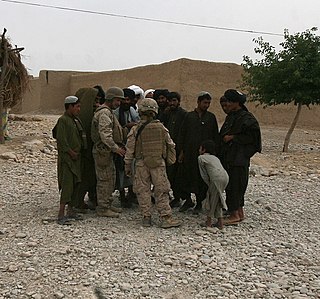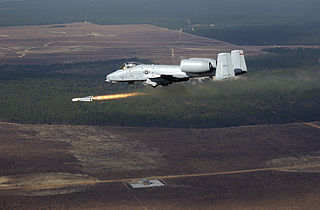
Military intelligence is a military discipline that uses information collection and analysis approaches to provide guidance and direction to assist commanders in their decisions. This aim is achieved by providing an assessment of data from a range of sources, directed towards the commanders' mission requirements or responding to questions as part of operational or campaign planning. To provide an analysis, the commander's information requirements are first identified, which are then incorporated into intelligence collection, analysis, and dissemination.

ISTAR stands for intelligence, surveillance, target acquisition, and reconnaissance. In its macroscopic sense, ISTAR is a practice that links several battlefield functions together to assist a combat force in employing its sensors and managing the information they gather.

The United States Strategic Command (USSTRATCOM) is one of the eleven unified combatant commands in the United States Department of Defense. Headquartered at Offutt Air Force Base, Nebraska, USSTRATCOM is responsible for strategic nuclear deterrence, global strike, and operating the Defense Department's Global Information Grid. It also provides a host of capabilities to support the other combatant commands, including integrated missile defense; and global command, control, communications, computers, intelligence, surveillance, and reconnaissance (C4ISR). This command exists to give "national leadership a unified resource for greater understanding of specific threats around the world and the means to respond to those threats rapidly".

The Combat Capabilities Development Command (CCDC) C5ISR Center, formerly the Communications-Electronics RD&E Center (CERDEC), is the United States Army information technologies and integrated systems center. CCDC C5ISR Center is headquartered at Aberdeen Proving Ground in Maryland, with activities at Fort Belvoir in Virginia and Joint Base McGuire-Dix-Lakehurst in New Jersey.

The Pine Bluff Arsenal is a United States Army installation in Jefferson County, Arkansas, about eight miles northwest of Pine Bluff and thirty miles southeast of Little Rock.

In the U.S., critical infrastructure protection (CIP) is a concept that relates to the preparedness and response to serious incidents that involve the critical infrastructure of a region or the nation. The American Presidential directive PDD-63 of May 1998 set up a national program of "Critical Infrastructure Protection". In 2014 the NIST Cybersecurity Framework was published after further presidential directives.
Qualified Weapons Instructor (QWI) (queue-why) is a qualification given to graduates of the Royal Air Force or Royal Navy Qualified Weapons Instructor courses. It is the equivalent to the United States Air Force Weapons School Course or US Navy's Naval Strike and Air Warfare Center warfare schools . Graduates of a QWI course are entitled to wear a QWI 'patch' on their flying suit or combat uniform, which denotes their status as an expert practitioner in their warfare specialty or platform. While QWI, TOPGUN and the United States Air Force Weapons School were traditionally associated with the employment of kinetic weapons and with historical origins in the combat aircraft community, modern warfare experts recognize that kinetic and non-kinetic weapons systems are critical in current and future combat engagements. This is reflected in the expansion of the respective warfare schools over the past two decades Recognizing this, the RAF has recently expanded the QWI qualification to included several non-kinetic fields and now strives to achieve Full Spectrum Warfare through effects based warfare. QWI is not to be confused with QFI Qualified Flying Instructor which is a non-tactical qualification.
The Joint Capabilities Integration and Development System (JCIDS) is the formal United States Department of Defense (DoD) process which defines acquisition requirements and evaluation criteria for future defense programs. JCIDS was created to replace the previous service-specific requirements generation system that allowed redundancies in capabilities and failed to meet the combined needs of all US military services. In order to correct these problems, JCIDS is intended to guide the development of requirements for future acquisition systems to reflect the needs of all four services by focusing the requirements generation process on needed capabilities as requested or defined by one of the US combatant commanders. In an ideal implementation of the JCIDS process, regional and functional combatant commanders give early and continuous feedback into the acquisition and sustainment processes to ensure their current and evolving requirements are known and met.
Battlespace or battle-space is a term used to signify a military strategy which integrates multiple armed forces for the military theatre of operations, including air, information, land, sea, cyber and outer space to achieve military goals. It includes the environment, factors, and conditions that must be understood to successfully apply combat power, protect the force, or complete the mission. This includes enemy and friendly armed forces, infrastructure, weather, terrain, and the electromagnetic spectrum within the operational areas and areas of interest.

Command and control is a "set of organizational and technical attributes and processes ... [that] employs human, physical, and information resources to solve problems and accomplish missions" to achieve the goals of an organization or enterprise, according to a 2015 definition by military scientists Marius Vassiliou, David S. Alberts, and Jonathan R. Agre. The term often refers to a military system.

Located at Kirtland Air Force Base, New Mexico, the Air Force Operational Test and Evaluation Center is a direct reporting unit of Headquarters, United States Air Force. It is the Air Force independent test agency responsible for testing, under operationally realistic conditions, new systems being developed for Air Force and multi-service use.
Intelligence cycle management refers to the overall activity of guiding the intelligence cycle, which is a set of processes used to provide decision-useful information (intelligence) to leaders. The cycle consists of several processes, including planning and direction, collection, processing and exploitation, analysis and production, and dissemination and integration. The related field of counterintelligence is tasked with impeding the intelligence efforts of others. Intelligence organizations are not infallible but, when properly managed and tasked, can be among the most valuable tools of management and government.

Special reconnaissance (SR) is conducted by small units, such as a recon team, made up of highly trained military personnel, usually from special forces units and/or military intelligence organizations. Special reconnaissance teams operate behind enemy lines, avoiding direct combat and detection by the enemy. As a role, SR is distinct from commando operations, but both are often carried out by the same units. The SR role frequently includes covert direction of airstrikes and indirect fire, in areas deep behind enemy lines, placement of remotely monitored sensors, and preparations for other special forces. Like other special forces, SR units may also carry out direct action and unconventional warfare, including guerrilla operations.
In United States military doctrine, unconventional warfare is one of the core activities of irregular warfare. Unconventional warfare is essentially support provided by the military to a foreign insurgency or resistance. The legal definition of UW is:
Unconventional Warfare consists of activities conducted to enable a resistance movement or insurgency to coerce, disrupt or overthrow an occupying power or government by operating through or with an underground, auxiliary or guerrilla force in a denied area.

Marine expeditionary unit (special operations capable) (MEU(SOC)) was a program created by the United States Marine Corps and the United States Navy in 1985 for Marine expeditionary units (MEU). As of 2013 the term MEU(SOC) is obsolete. The program enhanced MEUs providing them with additional training and equipment to become certified as special operations capable with a Maritime Special Purpose Force (MSPF). The designation special operations capable was unique to the Marine Corps and meant in relation to special operations. The role of a MEU(SOC) however was not equivalent to the special operations role of special operations forces. Although considered special operations capable a MEU(SOC) did not form part of the United States Special Operations Command (USSOCOM) established in 1987 or the United States Marine Forces Special Operations Command (MARSOC) later established in 2006.
The reconnaissance mission within the United States Marine Corps is divided into two distinct but complementary aspects; Marine Division Recon and Force Reconnaissance.

The Fleet Electronic Warfare Center (FEWC) is an organization established by Naval Network Warfare Command (NNWC) in 2008 to be the center for US Navy fleet electronic warfare (EW) operational and tactical issues. It is currently located at Navy Information Dominance Forces (NIDF) Headquarters, in Suffolk, VA as an independent directorate.

Persistent Close Air Support (PCAS) is a DARPA program that seeks to demonstrate dramatic improvements in close air support (CAS) capabilities by developing a system to allow continuous CAS availability and lethality to Joint Terminal Attack Controllers (JTACs).
Information Operations is a category of direct and indirect support operations for the United States Military. By definition in Joint Publication 3-13, "IO are described as the integrated employment of electronic warfare (EW), computer network operations (CNO), psychological operations (PSYOP), military deception (MILDEC), and operations security (OPSEC), in concert with specified supporting and related capabilities, to influence, disrupt, corrupt or usurp adversarial human and automated decision making while protecting our own." Information Operations (IO) are actions taken to affect adversary information and information systems while defending one's own information and information systems. In the United States Navy, information operations are often supervised by a Navy Information Operations Command (NIOC), for example in the United States Tenth Fleet which has several NIOCs.

Counter-IED efforts are done primarily by military and law enforcement with the assistance of the diplomatic and financial communities. It involves a comprehensive approach of countering the threat networks that employ improvised explosive devices (IEDs), defeating the devices themselves, and training others. Counter-IED, or C-IED, is usually part of a broader counter-terrorism, counter-insurgency, or law enforcement effort. Because IEDs are a subset of a number of forms of asymmetric warfare used by insurgents and terrorists, C-IED activities are principally against adversaries and not only against IEDs. C-IED treats the IED as a systemic problem and aims to defeat the IED threat networks themselves.











